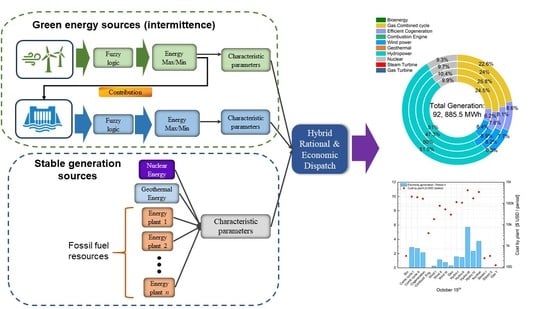Fuzzy Logic and Linear Programming-Based Power Grid-Enhanced Economical Dispatch for Sustainable and Stable Grid Operation in Eastern Mexico
Abstract
:1. Introduction
2. Materials and Methods
2.1. General Model
2.1.1. Modeling of Wind Energy Plants
2.1.2. Modeling of Hydraulic Power Plants
2.1.3. Economic Dispatch
2.2. Case of Study: Eastern Mexico Zone
3. Results
3.1. Electricity Generation Matrix
3.2. Electricity Cost by Plant
4. Discussion
- The intermittence of the wind generator is compensated for with the hydroelectric plants as long as they have enough capacity. In this way, the energy storage capacity of the hydroelectric plants is used to supply the energy generated by renewable energy sources.
- The remaining energy generation capacity to supply the total energy demand is distributed among the fossil fuel plants. This implies that some energy is generated by the thermoelectric plants to keep them operational and profitable.
- Once a fuzzy logic adjustment has been made to wind power based on its intermittency and a minimum reserve level of hydroelectric power is ensured, the model tries to satisfy the current demand with the cheapest technologies, taking into account the costs of turning a plant on and off. The increase in demand on a spring day is supplied with a gas turbine thermoelectric plant, which has a higher unit cost than nuclear. However, it is feasible to turn on the nuclear plant for the summer and autumn days when the consumption levels are higher.
5. Conclusions
Supplementary Materials
Author Contributions
Funding
Institutional Review Board Statement
Informed Consent Statement
Data Availability Statement
Acknowledgments
Conflicts of Interest
Nomenclature
| Subscripts | |
| Power plant | |
| Period | |
| Symbols | |
| Fixed cost of plant | |
| Variable cost of plant | |
| Silver start-up costs | |
| Demand requested | |
| Demand in period | |
| Energy to be generated by plant in period | |
| Minimum energy to be generated by plant j | |
| Maximum energy to be generated by plant | |
| Maximum descent ramp of floor | |
| Total number of plants in the system | |
| Total number of time periods | |
| Shutdown cost of plant | |
| Power to be generated from plant | |
| Minimum power to be generated by plant | |
| Maximum power to be generated by plant | |
| Total cost of power generation on the day | |
| Maximum ascent ramp of floor | |
| Binary variable: plant in operation | |
| Binary variable: operation of plant in period | |
| Binary variable: startup of plant in period | |
| Binary variable: stopage of plant in period | |
References
- Cantarero, M.M.V. Of renewable energy, energy democracy, and sustainable development: A roadmap to accelerate the energy transition in developing countries. Energy Res. Soc. Sci. 2020, 70, 101716. [Google Scholar] [CrossRef]
- Schleussner, C.F.; Rogelj, J.; Schaeffer, M.; Lissner, T.; Licker, R.; Fischer, E.; Knutti, R.; Levermann, A.; Frieler, K.; Hare, W. Science and policy characteristics of the Paris Agreement temperature goal. Nat. Clim. Chang. 2016, 6, 827–835. [Google Scholar] [CrossRef] [Green Version]
- Ayodele, T.R.; Ogunjuyigbe, A.S.O. Mitigation of wind power intermittency: Storage technology approach. Renew. Sustain. Energy Rev. 2015, 44, 447–456. [Google Scholar] [CrossRef]
- Moretti, M.; Njakou Djomo, S.; Azadi, H.; May, K.; De Vos, K.; Van Passel, S.; Witters, N. A systematic review of environmental and economic impacts of smart grids. Renew. Sustain. Energy Rev. 2017, 68, 888–898. [Google Scholar] [CrossRef]
- He, L.; Lu, Z.; Geng, L.; Zhang, J.; Li, X.; Guo, X. Environmental economic dispatch of integrated regional energy system considering integrated demand response. Int. J. Electr. Power Energy Syst. 2020, 116, 105525. [Google Scholar] [CrossRef]
- Ahmadi, P.; Dincer, I. 5.9 Optimization in Energy Management. In Comprehensive Energy Systems; Ibrahim, D., Ed.; Elsevier: Amsterdam, The Netherlands, 2018; Volume 5, pp. 351–388. [Google Scholar] [CrossRef]
- Suganthi, L.; Samuel, A.A. Energy models for demand forecasting—A review. Renew. Sustain. Energy Rev. 2012, 16, 1223–1240. [Google Scholar] [CrossRef]
- Yue, X.; Pye, S.; DeCarolis, J.; Li, F.; Rogan, F.; Gallachóir, B. A review of approaches to uncertainty assessment in energy system optimization models. Energy Strategy Rev. 2018, 21, 204–217. [Google Scholar] [CrossRef]
- Mayer, M.J.; Szilágyi, A.; Gróf, G. Environmental and economic multi-objective optimization of a household level hybrid renewable energy system by genetic algorithm. Appl. Energy 2020, 269, 115058. [Google Scholar] [CrossRef]
- Fotopoulou, M.; Rakopoulos, D.; Blanas, O. Day, Ahead Optimal Dispatch Schedule in a Smart Grid Containing Distributed Energy Resources and Electric Vehicles. Sensors 2021, 21, 7295. [Google Scholar] [CrossRef]
- Di Pilla, L.; Desogus, G.; Mura, S.; Ricciu, R.; Di Francesco, M. Optimizing the distribution of Italian building energy retrofit incentives with Linear Programming. Energy Build. 2016, 112, 21–27. [Google Scholar] [CrossRef]
- McLarty, D.; Panossian, N.; Jabbari, F.; Traverso, A. Dynamic economic dispatch using complementary quadratic programming. Energy 2019, 166, 755–764. [Google Scholar] [CrossRef]
- Arabali, A.; Ghofrani, M.; Etezadi-Amoli, M.; Fadali, M.; Baghzouz, Y. Genetic-Algorithm-Based Optimization Approach for Energy Management. IEEE Trans. Power Deliv. 2013, 28, 162–170. [Google Scholar] [CrossRef]
- Kawaguchi, S.; Fukuyama, Y. Reactive Tabu Search for Job-shop scheduling problems considering peak shift of electric power energy consumption. In Proceedings of the IEEE Region 10 Conference (TENCON). Marina Bay Sands, Singapore, 22–25 November 2016. [Google Scholar] [CrossRef]
- Killian, M.; Zauner, M.; Kozek, M. Comprehensive smart home energy management system using mixed-integer quadratic-programming. Appl. Energy 2018, 222, 662–672. [Google Scholar] [CrossRef]
- Rodzin, S.I. Smart dispatching and metaheuristic swarm flow algorithm. J. Comput. Syst. Sci. Int. 2014, 53, 109–115. [Google Scholar] [CrossRef]
- McBratney, A.B.; Odeh, I.O.A. Application of fuzzy sets in soil science: Fuzzy logic, fuzzy measurements, and fuzzy decisions. Geoderma 1997, 77, 85–113. [Google Scholar] [CrossRef]
- Vojtáš, P. Fuzzy logic programming. Fuzzy Sets Syst. 2001, 124, 361–370. [Google Scholar] [CrossRef]
- Kumar, R.; Chauhan, A.; Aggarwal, A. Devising a new technique for all-thermal economic dispatch problem’s solution employing angular fuzzy sets and variation factor. In Proceedings of the Communication, Control and Intelligent Systems (CCIS 2015), Mathura, India, 7–8 November 2015. [Google Scholar] [CrossRef]
- Miranda, V.; Hang, P.S. Economic dispatch model with fuzzy wind constraints and attitudes of dispatchers. IEEE Trans. Power Syst. 2005, 20, 2143–2145. [Google Scholar] [CrossRef] [Green Version]
- Roa-Sepulveda, C.A.; Herrera, M.; Pavez-Lazo, B.; Knight, U.G.; Coonick, A.H. Economic dispatch using fuzzy decision trees. Electr. Power Syst. Res. 2003, 66, 115–122. [Google Scholar] [CrossRef]
- Song, Y.H.; Wang, G.S.; Wang, P.Y.; Johns, A.T. Environmental/economic dispatch using fuzzy logic controlled genetic algorithms. IEEE Proc.-Gener. Transm. Distrib. 1997, 144, 377–382. [Google Scholar] [CrossRef]
- Nasiruzzaman, A.B.M.; Rabbani, M.G. Implementation of Genetic Algorithm and fuzzy logic in economic dispatch problem. In Proceedings of the International Conference on Electrical and Computer Engineering, Dhaka, Bangladesh, 20–22 December 2008. [Google Scholar] [CrossRef]
- Niknam, T.; Mojarrad, H.D.; Nayeripour, M. A new fuzzy adaptive particle swarm optimization for non-smooth economic dispatch. Energy 2010, 35, 1764–1778. [Google Scholar] [CrossRef]
- Somasundaram, P.; Swaroopan, N.J. Fuzzified Particle Swarm Optimization Algorithm for Multi-area Security Constrained Economic Dispatch. Electr. Power Comp. Syst. 2011, 39, 979–990. [Google Scholar] [CrossRef]
- Al-Sakkaf, S.; Kassas, M.; Khalid, M.; Abido, M.A. An energy management system for residential autonomous DC microgrid using optimized fuzzy logic controller considering economic dispatch. Energies 2019, 12, 1457. [Google Scholar] [CrossRef] [Green Version]
- Hetzer, J.; David, C.Y.; Bhattarai, K. An economic dispatch model incorporating wind power. IEEE Trans. Energy Convers. 2008, 23, 603–611. [Google Scholar] [CrossRef]
- Meje, K.; Bokopane, L.; Kusakana, K.; Siti, M. Optimal power dispatch in a multisource system using fuzzy logic control. Energy Rep. 2020, 6, 1443–1449. [Google Scholar] [CrossRef]
- López, E.; Domínguez-Cruz, R.F.; Salgado-Tránsito, I. Optimization of Power Generation Grids: A Case of Study in Eastern Mexico. Math. Comput. Appl. 2021, 26, 46. [Google Scholar] [CrossRef]
- The Royal Meteorological Society. The Beaufort Scale. Available online: https://www.rmets.org/metmatters/beaufort-scale (accessed on 2 March 2022).
- Precup, R.E.; Hellendoorn, H. A survey on industrial applications of fuzzy control. Comp. Ind. 2011, 62, 213–226. [Google Scholar] [CrossRef]
- García-Gutiérrez, H.; Nava-Mastache, A. Selección y Dimensionamiento de Turbinas Hidráulicas para Centrales Hidroeléctricas, 1st ed.; Universidad Nacional Autónoma de México, Facultad de Ingeniería, Cuidad de México: Ciudad de México, México, 2013; pp. 56–82. [Google Scholar]
- Centro Nacional de Control de Energía (CENACE México). Demandas del Sistema Eléctrico Nacional. Available online: https://www.cenace.gob.mx/Paginas/Publicas/Info/DemandaRegional.aspx (accessed on 2 March 2022).
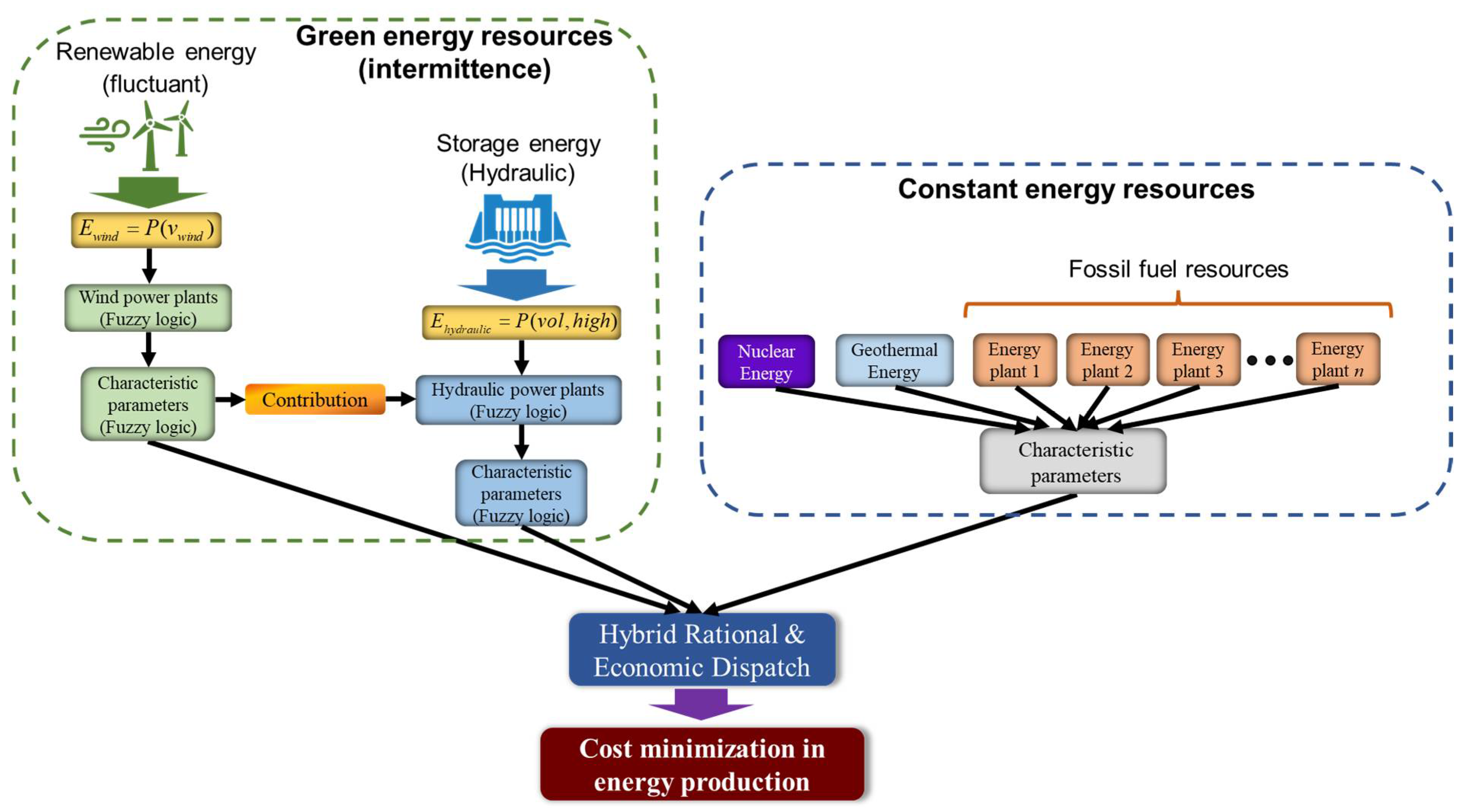
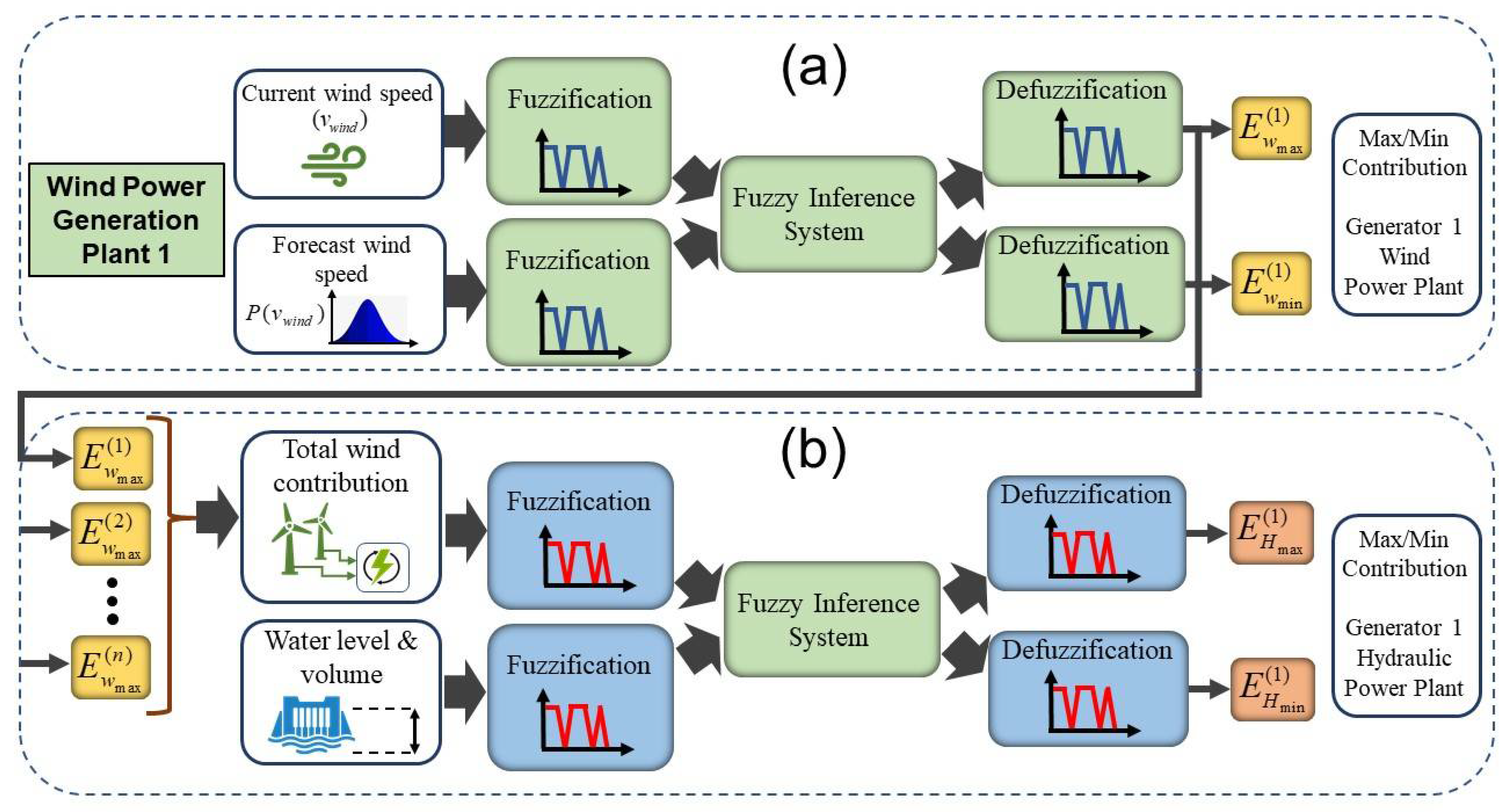
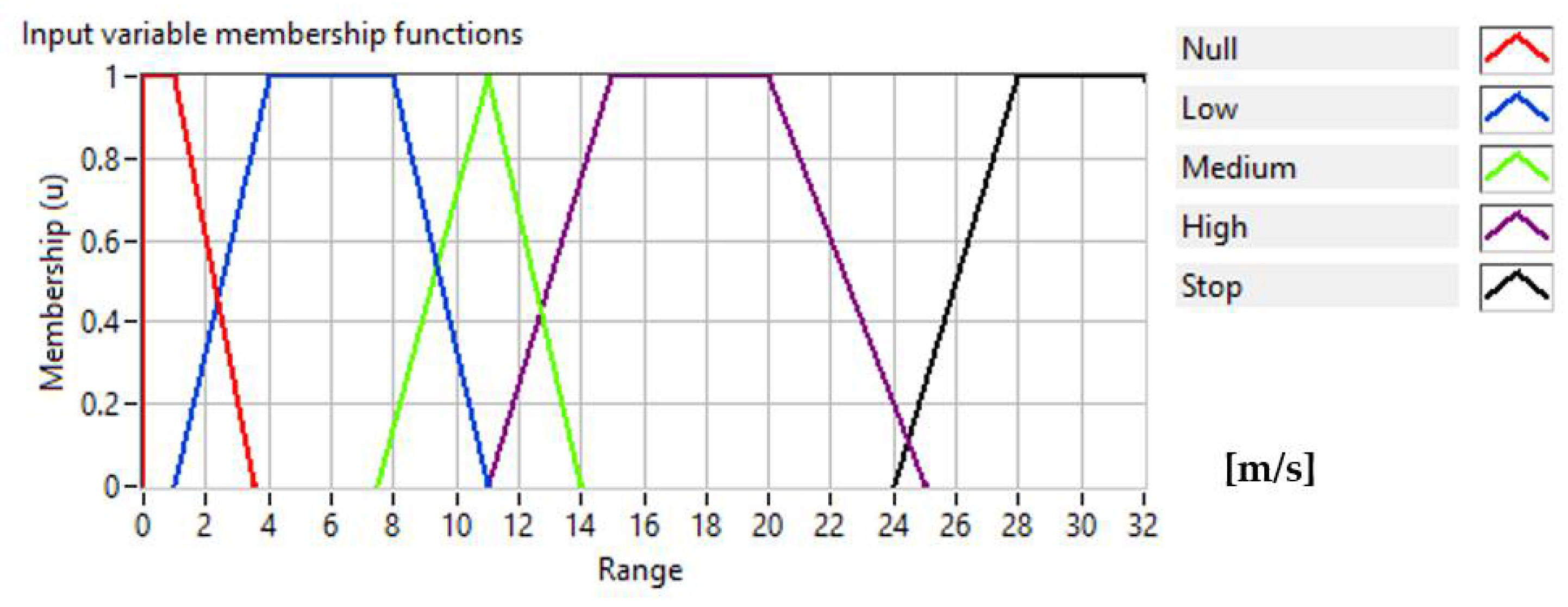
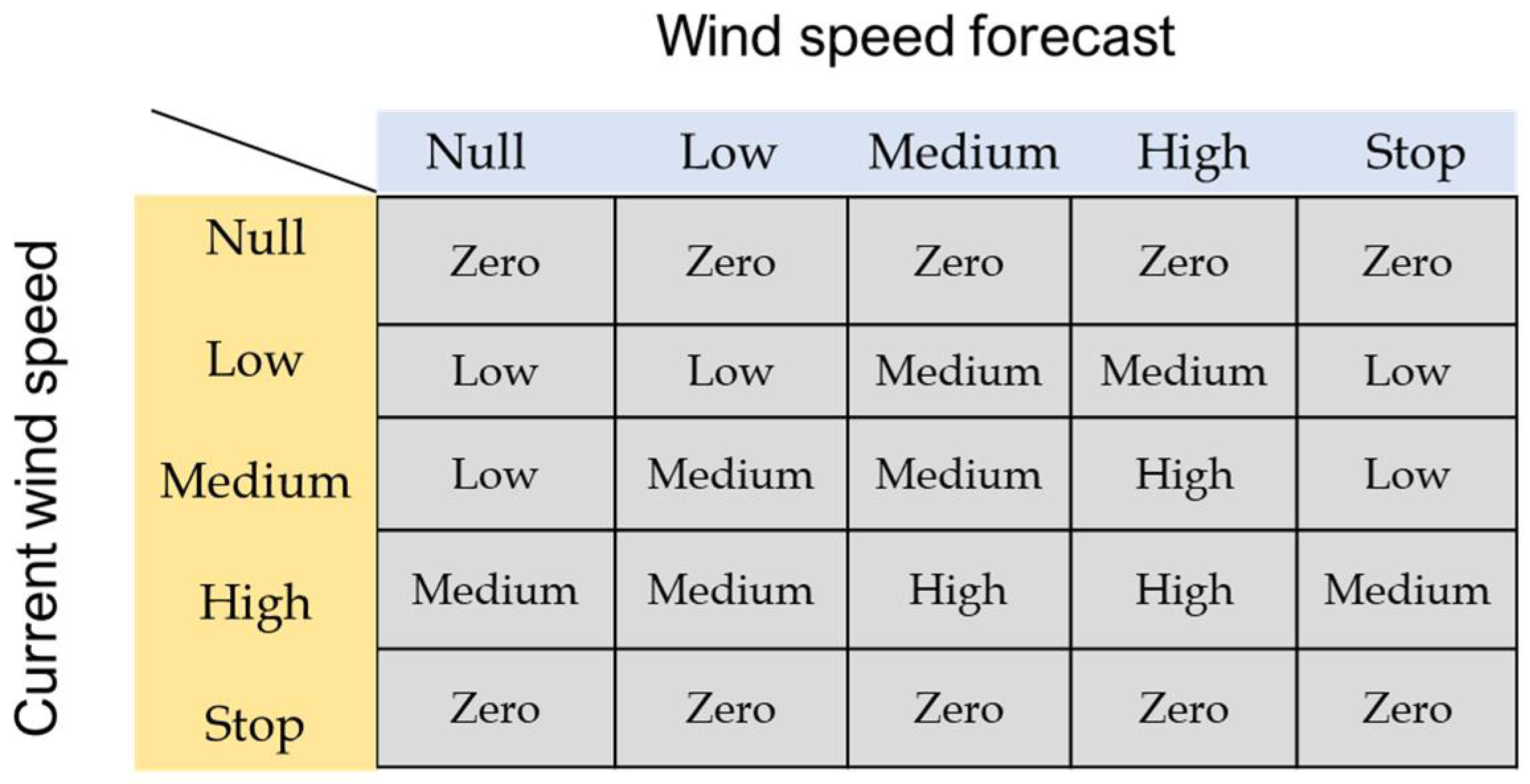

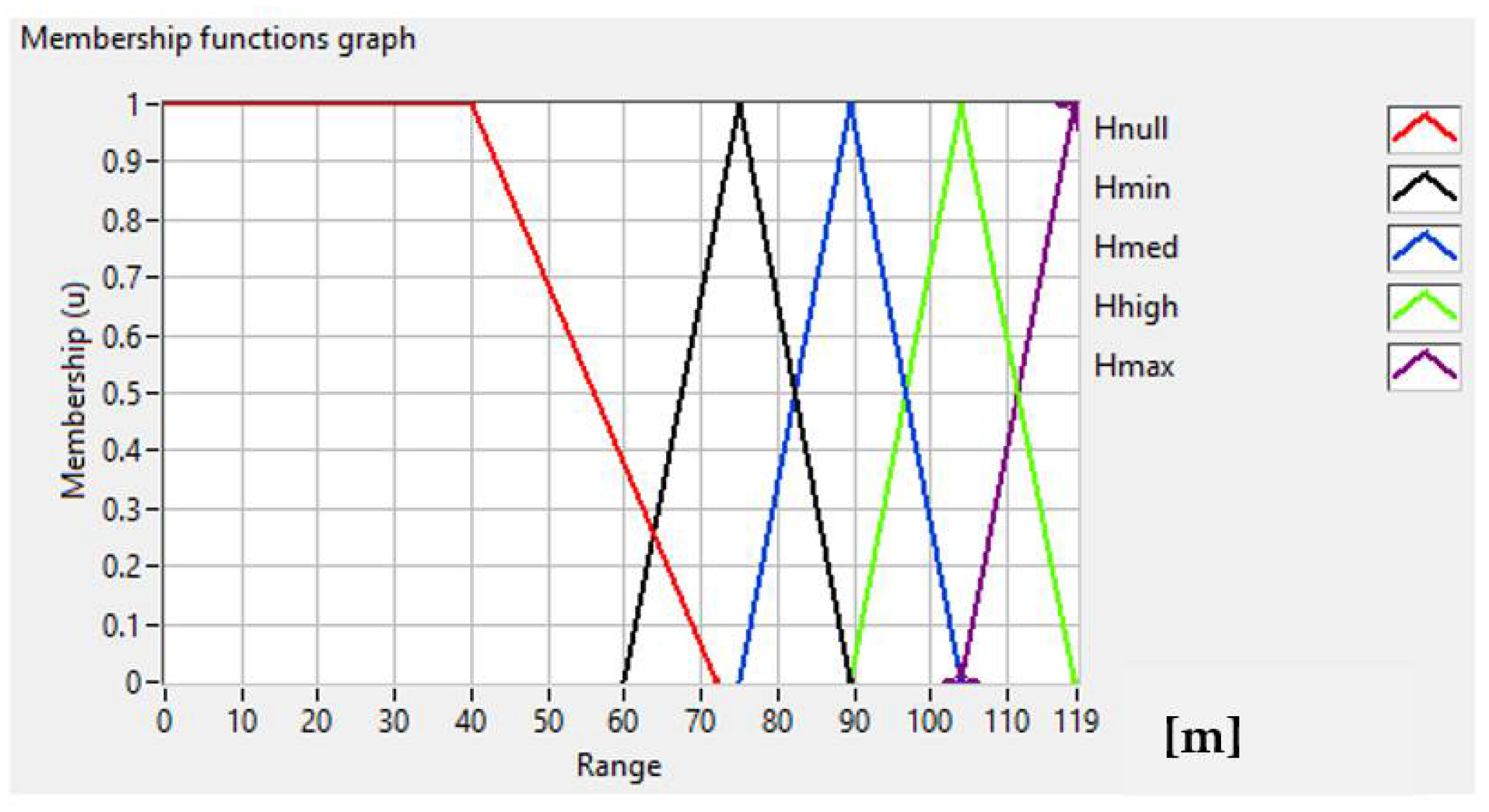
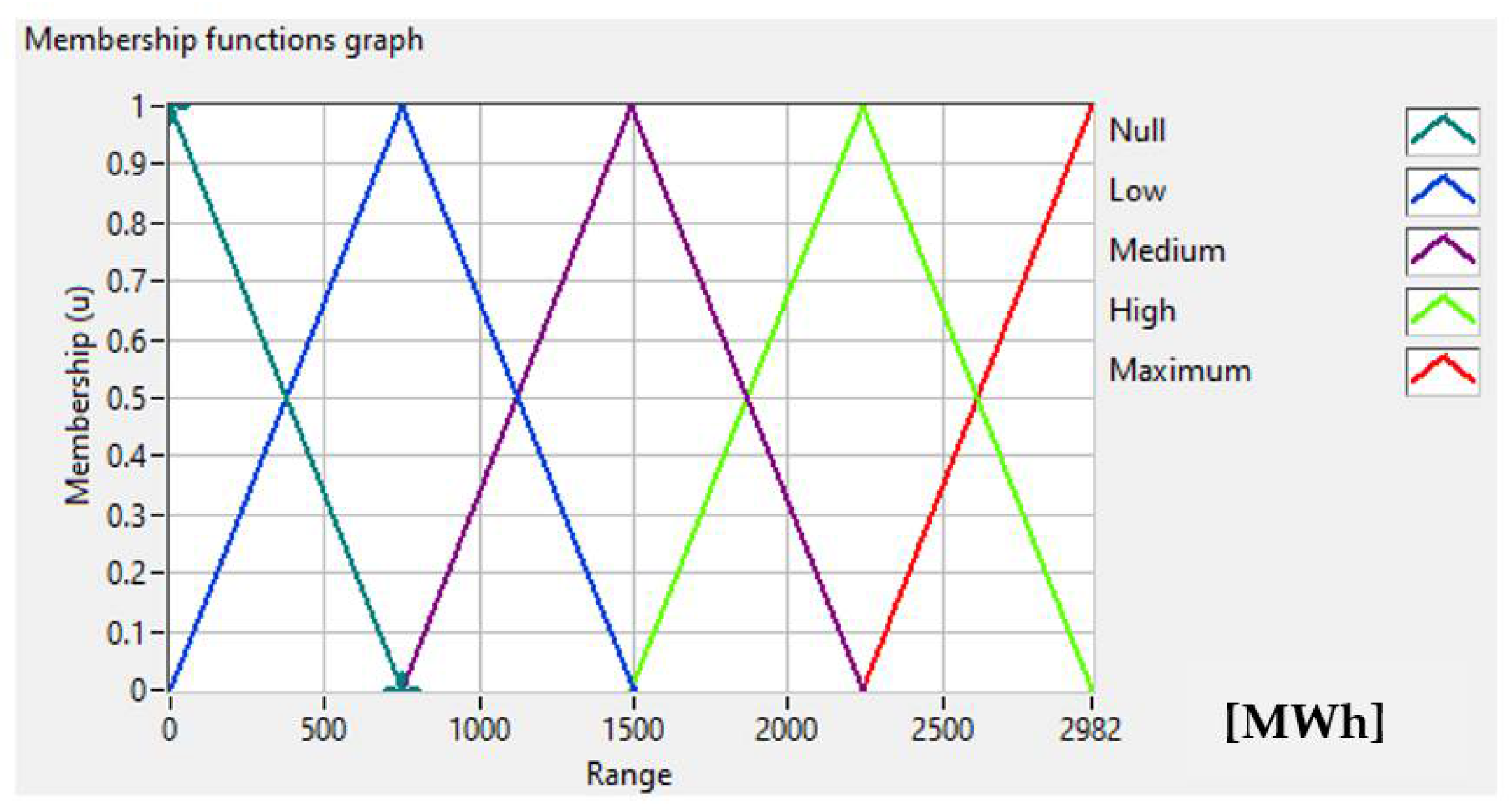


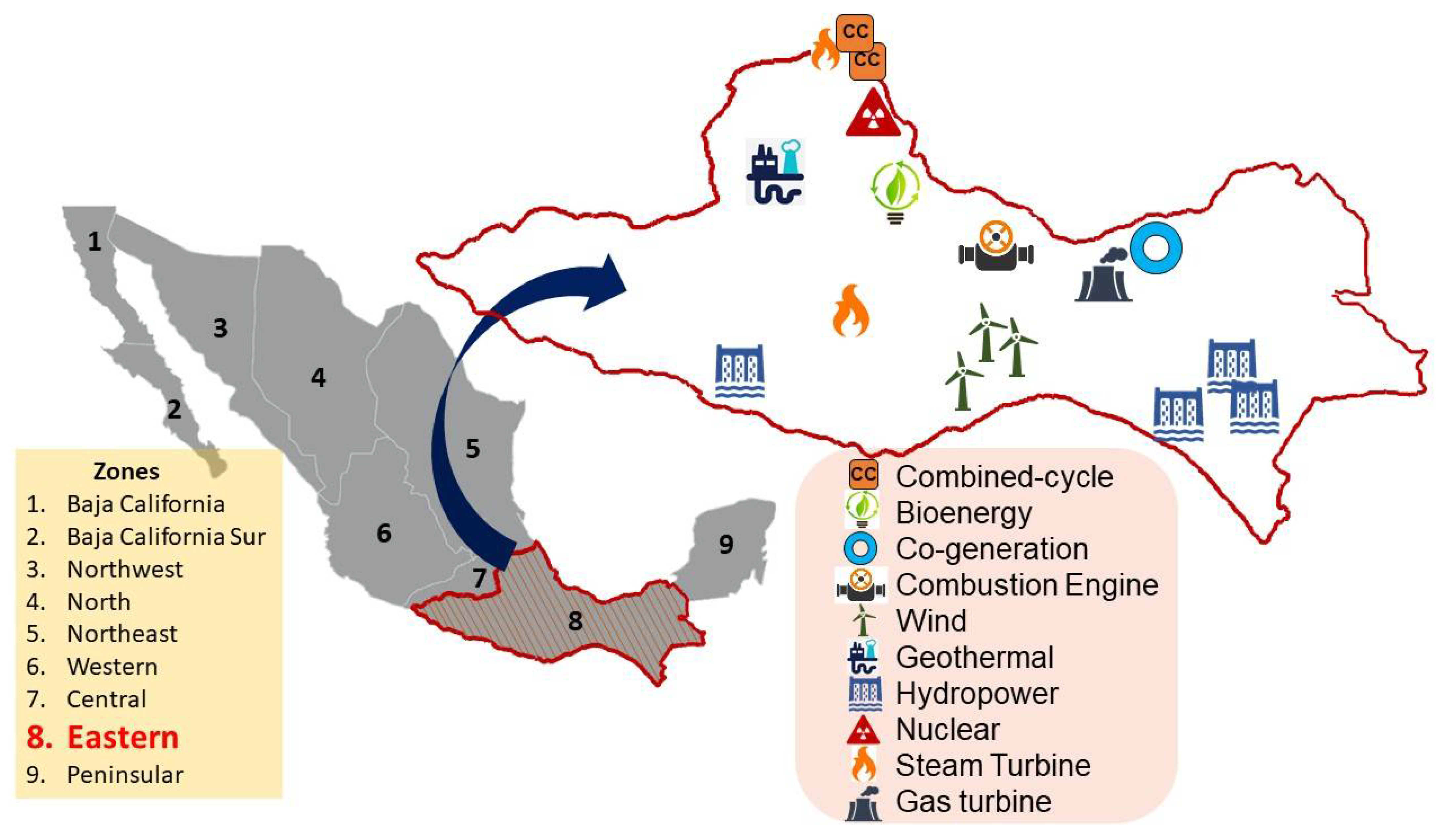
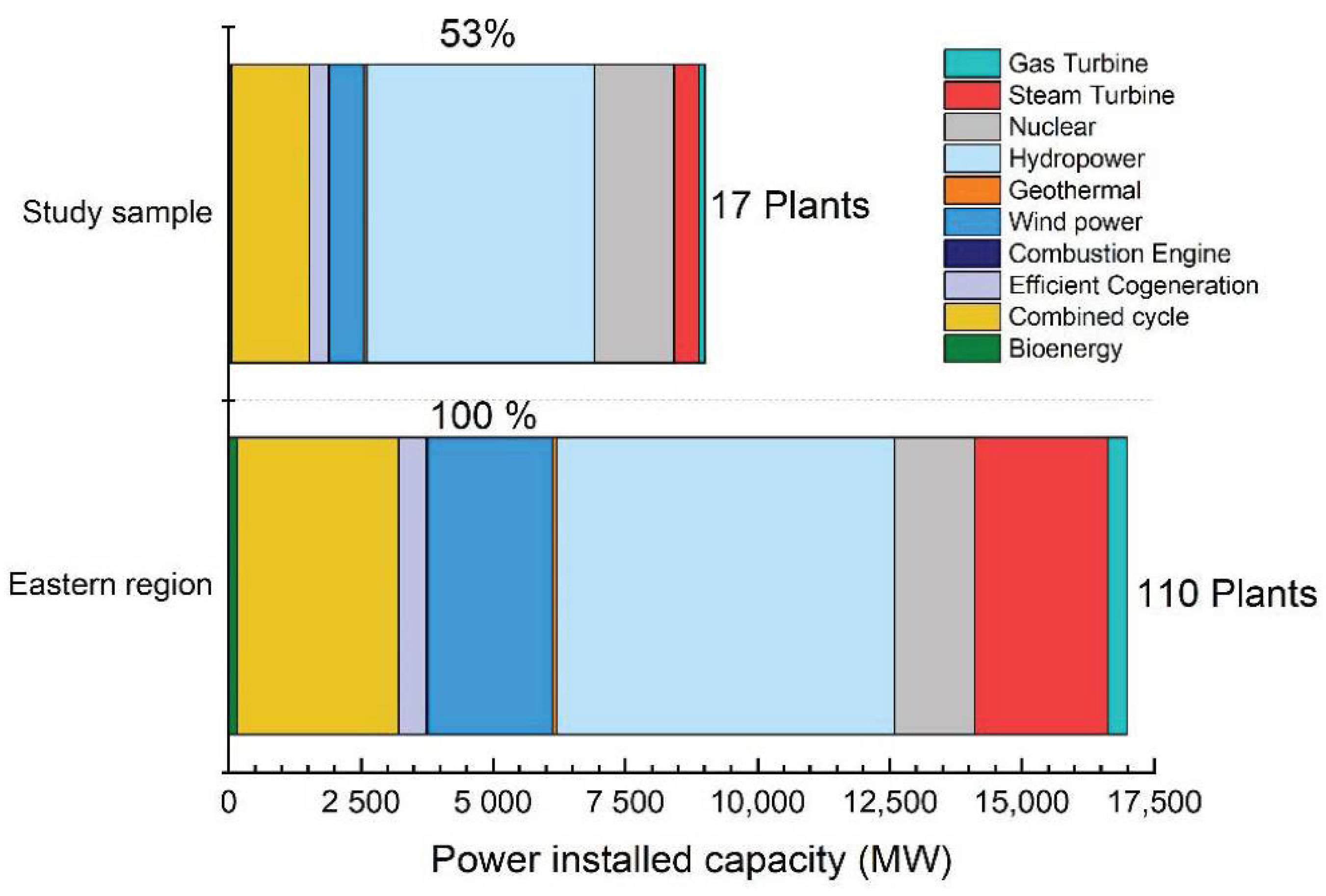

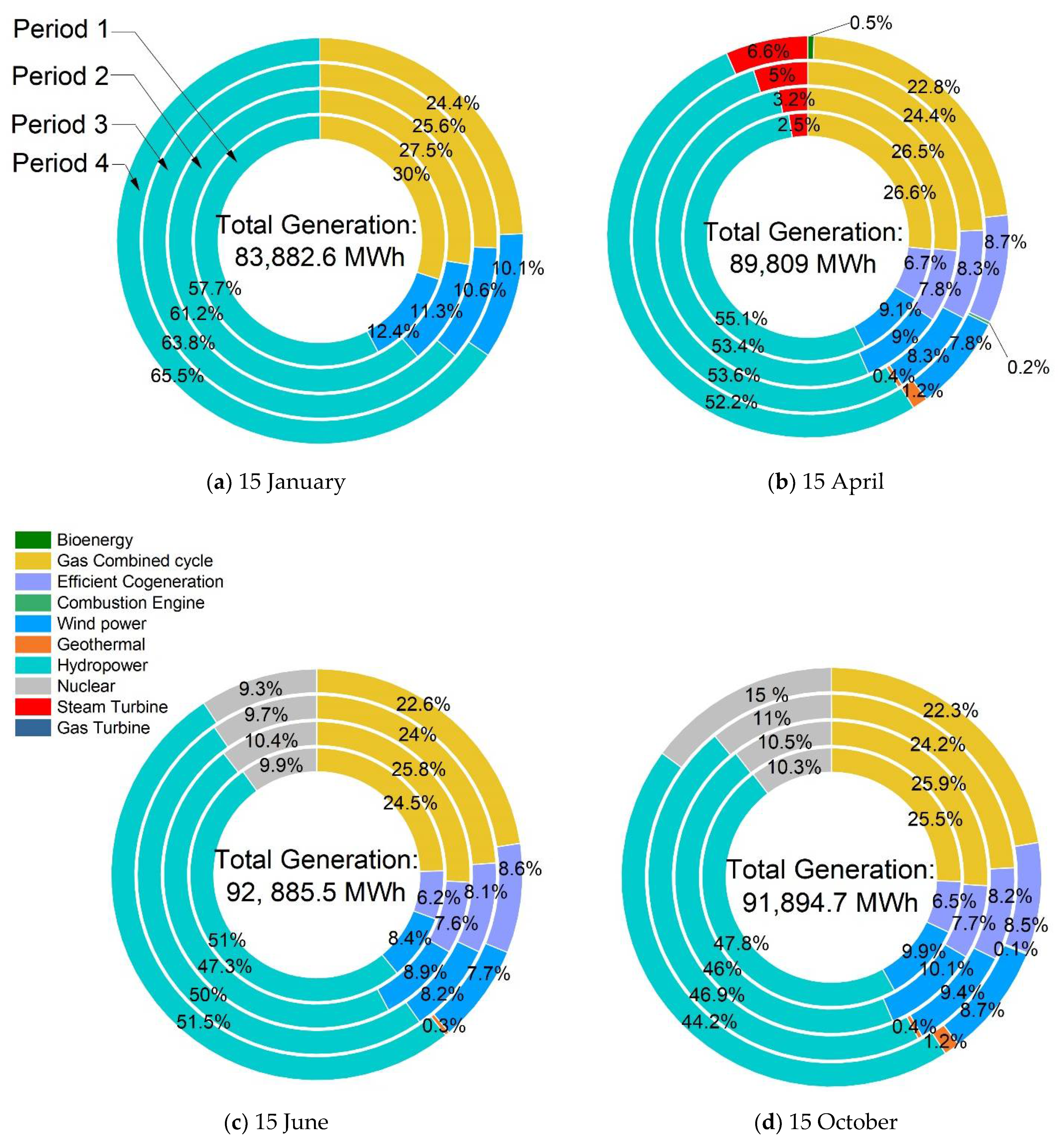
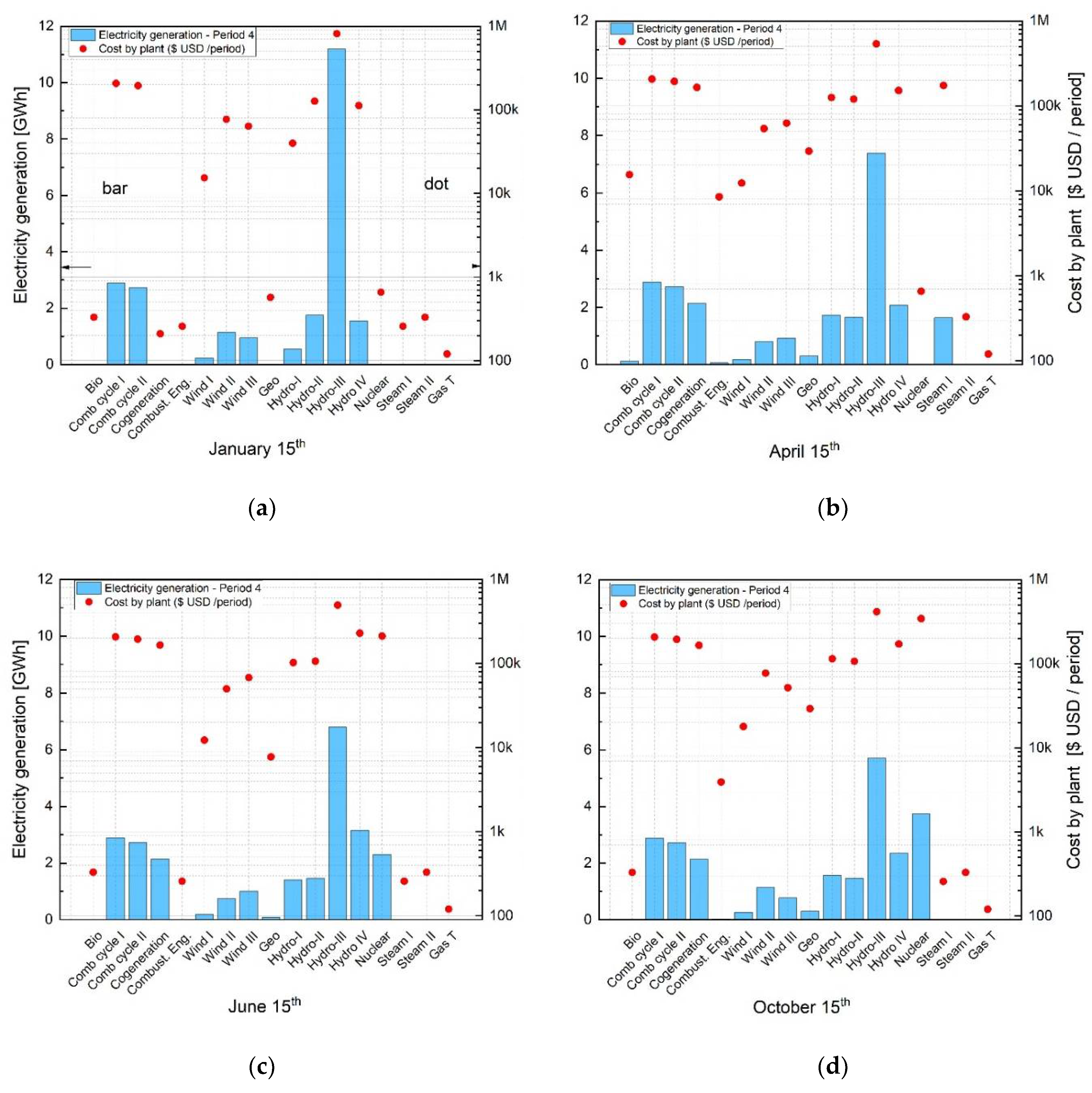
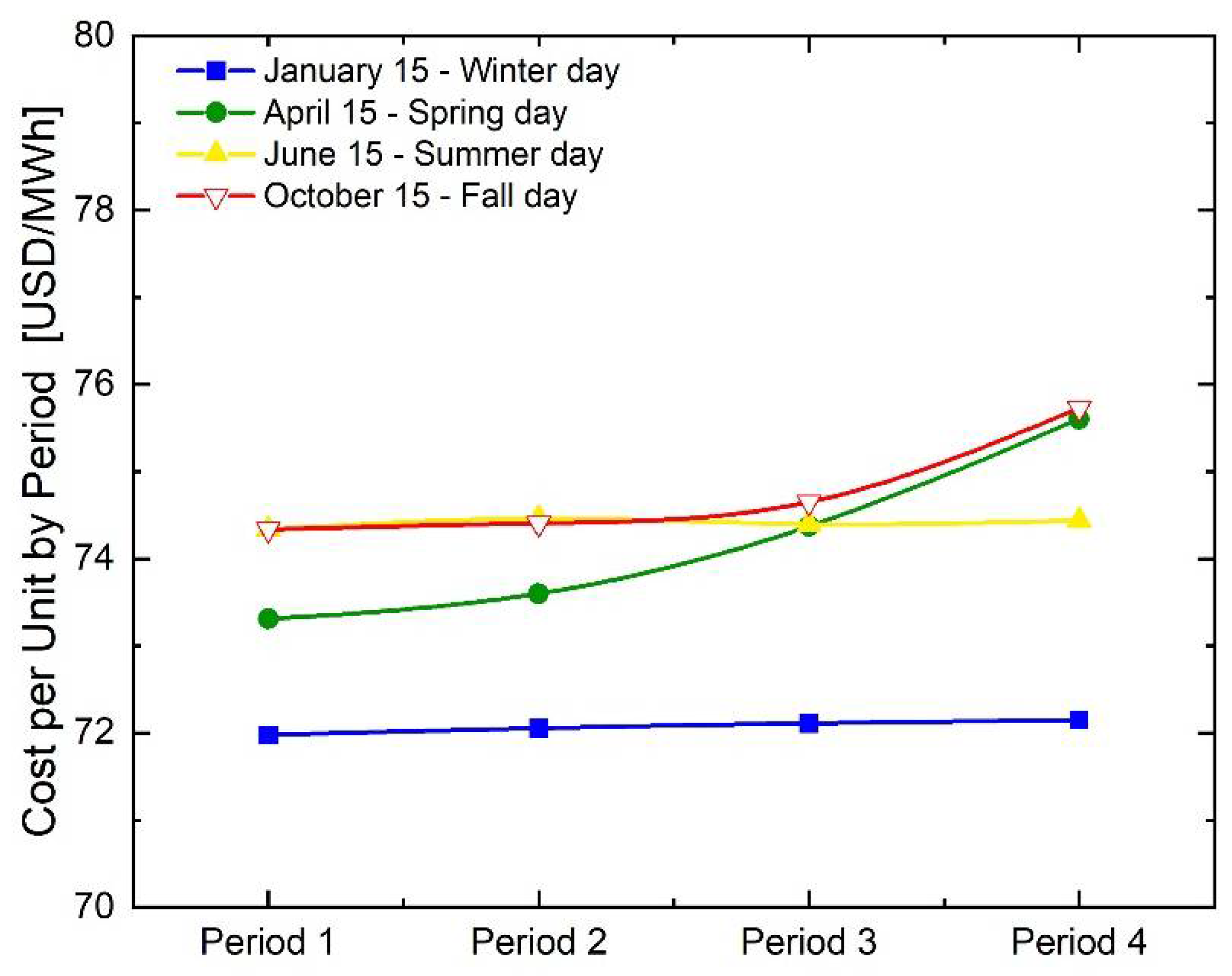
| Type of Wind | Minimum Speed m/s | Maximum Speed m/s |
|---|---|---|
| Calm | 0 | 0.4 |
| Light Air | 0.5 | 1.5 |
| Light Breeze | 1.6 | 3.4 |
| Gentle Breeze | 3.5 | 5.5 |
| Moderate Breeze | 5.5 | 8 |
| Fresh Breeze | 8.1 | 10.9 |
| Strong gale | 11.4 | 13.9 |
| Fresh Breeze | 14.1 | 16.9 |
| Fresh gale | 17.4 | 20.4 |
| Stong gale | 20.5 | 23.9 |
| Whole gale | 24.4 | 28 |
| Storm | 28.4 | 32.5 |
| Hurricane | 32.6 | - |
| Fuzzification | Range [m/s] |
|---|---|
| Null | [0–3.4] |
| Low | [3.5–8] |
| Medium | [8.1–10.9] |
| High | [11–23.9] |
| Stop | [24–-] |
| Fuzzification | Water Height (m) |
|---|---|
| Null | (0–3.4) |
| Low | (3.5–8) |
| Medium | (8.1–10.9) |
| High | (11–23.9) |
| Stop | (24–-) |
| 15 January (MWh) | 15 April (MWh) | 15 June (MWh) | 15 October (MWh) | |
|---|---|---|---|---|
| Period 1 | 18,695.8 | 21,065.0 | 22,882.0 | 21,951.8 |
| Period 2 | 20,382.4 | 21,158.3 | 21,750.6 | 21,670.1 |
| Period 3 | 21,866.9 | 22,973.4 | 23,399.2 | 23,191.4 |
| Period 4 | 22,937.5 | 24,612.3 | 24,853.8 | 25,081.4 |
| Total | 83,882.6 | 89,809.0 | 92,885.6 | 91,894.7 |
Publisher’s Note: MDPI stays neutral with regard to jurisdictional claims in published maps and institutional affiliations. |
© 2022 by the authors. Licensee MDPI, Basel, Switzerland. This article is an open access article distributed under the terms and conditions of the Creative Commons Attribution (CC BY) license (https://creativecommons.org/licenses/by/4.0/).
Share and Cite
López-Garza, E.; Domínguez-Cruz, R.F.; Martell-Chávez, F.; Salgado-Tránsito, I. Fuzzy Logic and Linear Programming-Based Power Grid-Enhanced Economical Dispatch for Sustainable and Stable Grid Operation in Eastern Mexico. Energies 2022, 15, 4069. https://doi.org/10.3390/en15114069
López-Garza E, Domínguez-Cruz RF, Martell-Chávez F, Salgado-Tránsito I. Fuzzy Logic and Linear Programming-Based Power Grid-Enhanced Economical Dispatch for Sustainable and Stable Grid Operation in Eastern Mexico. Energies. 2022; 15(11):4069. https://doi.org/10.3390/en15114069
Chicago/Turabian StyleLópez-Garza, Esmeralda, René Fernando Domínguez-Cruz, Fernando Martell-Chávez, and Iván Salgado-Tránsito. 2022. "Fuzzy Logic and Linear Programming-Based Power Grid-Enhanced Economical Dispatch for Sustainable and Stable Grid Operation in Eastern Mexico" Energies 15, no. 11: 4069. https://doi.org/10.3390/en15114069
APA StyleLópez-Garza, E., Domínguez-Cruz, R. F., Martell-Chávez, F., & Salgado-Tránsito, I. (2022). Fuzzy Logic and Linear Programming-Based Power Grid-Enhanced Economical Dispatch for Sustainable and Stable Grid Operation in Eastern Mexico. Energies, 15(11), 4069. https://doi.org/10.3390/en15114069







